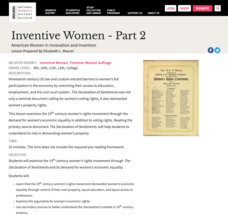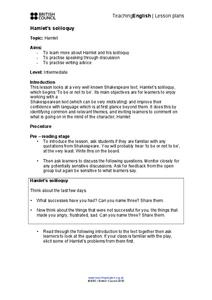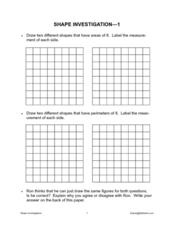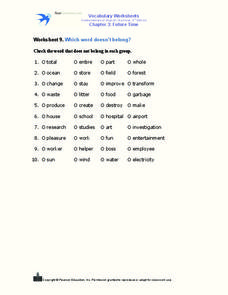Space Awareness
Seasons Around the World
Why does Earth experience summer, fall, winter, and spring? Using an informative demonstration, learners see how the angle of the sun on Earth and the rotation of Earth determine the seasons. Scholars work in pairs to learn that the...
National Woman's History Museum
Inventive Women - Part 2
The Declaration of Independence was published in 1776. The Declaration of Sentiments and Resolutions, modeled after the Declaration of Independence, was drafted and read by Elizabeth Cady Stanton at the Seneca Falls Convention in 1848....
Curated OER
Puberty/Adolescence, Day 4: "Will I Fit in?"
What are healthy friendships? What makes a friendship unhealthy? There are several worksheets for your high schoolers to do to answer some of these questions and more about their friends and ideas about friendship. Inspire some great...
Curated OER
Types of Reactions
In this reactions worksheet, students complete the given reactions by writing the products. Students do examples of composition, decomposition, single replacement, double replacement, and combustion reactions. This worksheet has 54...
Curated OER
Cuentitos para ni
Vamos a escribir! Your older learners will love writing a children's book for learners at the elementary level. The resource suggests having small groups write their stories and create PowerPoint slides with illustrations, but this can...
Curated OER
Significant Figures in Calculations
Significant figures estimate the precision of your calculations. Teach your high school scientists how to count and identify significant figures at the beginning of the school year so that they are adept at using them in their...
Curated OER
Compare the Presidents
How are Nicolas Sarkozy and Barack Obama similar? How are they different? Look at two visual representations of them; what kind of first impression does they give you? After comparing the presidents, learners complete a proverb matching...
Curated OER
Miss America
The first part of this article by PBS on the Miss America pageants can be used in a health class when it's time to talk about body image. There are links to related articles. There are some great questions for discussion. There are ideas...
Curated OER
Soap Boat
When two vowels go walking, who does the talking? Learners explore this question with several activities featuring words with OA, AI, and EA. The activity includes many fun pictures and requires different skills sets such as context...
Curated OER
Hamlet's Soliloquy
Everyone is familiar with the beginning of Hamlet's soliloquy, "To be or not to be..." While reading Hamlet, help your middle schoolers analyze the lines that follow, but how do you help them make personal connections to the text? Use...
Mathwire
Shape Investigation: Area and Perimeter
Does a shape's perimeter always match its area? Learners approach this and other claims in this shape investigation worksheet. Using blank grids, they draw various shapes based on required perimeter and area measurements, labelling the...
Florida Center for Reading Research
Phonological Awareness: Rhyme, Rhyme or No Rhyme
Rhyming is fun, builds phonemic awareness, and is a tried and true pre-reading skill. This activity helps learners identify words that rhyme. Young scholars listen to a song, locate a rhyming word they hear by clapping then draw a...
Curated OER
Comparing Two Stories
Compare new and old versions of the classic story Alice in Wonderland in this comprehensive learning exercise packet. Learners read an excerpt from the original, answering several analysis questions. They do the same for a more...
Curated OER
Auxiliary Verbs Exercises
For this gap fill worksheet, students fill in the blanks to sentences with do, does, doesn't, don't, am, is, are, or I'm. Students complete 45 sentences.
Curated OER
Question Tags - Negative
In this negative expression worksheet, students fill in the blanks to negative expressions with either the word am, is, are, do, or does. Students complete 10 sentences.
Curated OER
Present Unreal Situations: strategizing with hypothetical statements
In this hypothetical statements worksheet, students choose the correct the phrases in the sentences about what they would do hypothetically. Students complete 8 problems.
Curated OER
Classification of Words and Ideas
In this classification worksheet, students pick the words that do not belong, make up the title for groups of words, and choose the title for the group of words. Students complete 3 activities.
Curated OER
Total English Upper Intermediate: People and Their Personalities
In this can do statements worksheet, students practice the phrases it's time, I'd rather, and I'd better as they respond to 20 questions that include sentence starters and vocabulary to describe characteristics of people in certain...
Curated OER
Worksheet 9: Which Word Doesn't Belong?
For this words that go together worksheet, students analyze a group of four words and determine anything they have in common. Students check the word that does not belong in each group.
Curated OER
Mind Over Matter: How Does the Brain Work
Students research previous attempts by scientists to discover the ways in which the brain works, design and conduct an experiment to illustrate current research and present their findings to the class.
Curated OER
What Do You Want to Do?
This short story activity can be a good way to have learners practice comprehension and test preparation skills. While the passage is short, the 9-question activity can help students cement their test taking abilities.
Curated OER
Math - Does It Add Up? Applying Arithmetic Operations to Solve Everyday Problems
In this story problem worksheet, student find ten math problems in the story, write the problems down and say what type of calculation it was. Students also complete 12 computation problems.
Curated OER
What Does Time Have to Do with it?
Students investigate time. In this investigative lesson, students run through an obstacle course using standard timers. They record the time and apply this knowledge to problems in math. Students record their predictions, and graph...
Curated OER
Investigation - What Does 1,000 Look Like?
Second graders determine what 1,000 items look like. In this math investigation instructional activity, 2nd graders collect 1,000 items and determine the best way to count them by tens and hundreds. They can use stickers on notecards to...
Other popular searches
- Picture Does Not Belong
- Al Capone Does My Shirts
- Do and Does
- Does
- Which Word Does Not Belong
- Does Not Belong
- How Does Light Travel
- Sentence Does Not Belong
- Which Does Not Belong
- Anansi Does the Impossible
- Does Salt Evaporate
- Where Does Food Come From























